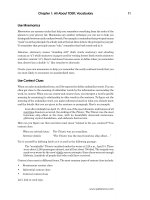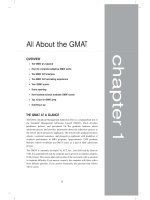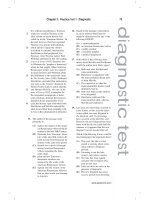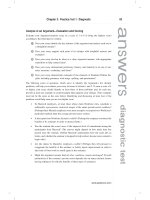Master gmat 2010 part 3 docx
Bạn đang xem bản rút gọn của tài liệu. Xem và tải ngay bản đầy đủ của tài liệu tại đây (62.39 KB, 10 trang )
All About the GMAT
OVERVIEW
• The GMAT at a glance
• How the computer-adaptive GMAT works
• The GMAT CAT interface
• The GMAT CAT test-taking experience
• Your GMAT scores
• Score reporting
• How business schools evaluate GMAT scores
• Top10tipsforGMATprep
• Summing it up
THE GMAT AT A GLANCE
The GMAT (Graduate Management Admission Test) is a standardized test of
the Graduate Management Admission Council (GMAC), which develops
guidelines, policies, and procedures for the graduate business school
admission process and provides information about the admission process to
the schools and to prospective applicants. The test provides graduate business
schools, vocational counselors, and prospective applicants with predictors of
academic performance in MBA programs. Approximately 1,900 graduate
business schools worldwide use GMAT scores as a part of their admissions
process.
The GMAT is currently developed by ACT, Inc., and delivered by Pearson
VUE. It is administered only by computer and is given in a computer-adaptive
(CAT) format. This means that each section of the test starts with a question
of moderate difficulty. If you answer correctly, the computer will follow with a
more difficult question. If you answer incorrectly, the question that follows
will be easier.
chapter 1
3
The GMAT contains three parts: an Analytical Writing Assessment (AWA) section, a
Quantitative section, and a Verbal section. The total testing time (excluding breaks) is 3
hours, 30 minutes. Here’s the basic structure of the test.
Analytical Writing Assessment (Sections 1 and 2)
Analysis of an Issue (one writing task, 30-minute time limit)
Analysis of an Argument (one writing task, 30-minute time limit)
Optional break (10-minute time limit)
Quantitative (Section 3)
(37 multiple-choice questions, 75-minute time limit)
Problem Solving (22–23 questions)
Data Sufficiency (14–15 questions)
Optional break (10-minute time limit)
Verbal (Section 4)
(41 multiple-choice questions, 75-minute time limit)
Critical Reasoning (14–15 questions)
Sentence Correction (14–15 questions)
Reading Comprehension (12–13 questions, divided among four sets)
Sequence of Exam Sections
Sections 1 and 2 (the two timed essay sections) always appear first, before the two timed
multiple-choice sections. Section 3 is always Quantitative Ability, and section 4 is always
Verbal Ability.
Sequence of Questions in Quantitative and Verbal
In each of the two multiple-choice sections, question types are interspersed. Here’s a typical
sequence for each section (on the actual GMAT, the sequence might be different):
Quantitative Ability (Typical Sequence of Questions)
Questions 1–2 Problem Solving
Questions 3–7 Data Sufficiency
Questions 8–13 Problem Solving
Question 14 Data Sufficiency
Question 15 Problem Solving
Question 16 Data Sufficiency
Questions 17–21 Problem Solving
Questions 22–27 Data Sufficiency
Questions 28–34 Problem Solving
Question 35 Data Sufficiency
Questions 36–37 Problem Solving
4 PART I: GMAT Basics
www.petersons.com
Verbal Ability (Typical Sequence of Questions)
Questions 1–3 Sentence Correction
Questions 4–5 Critical Reasoning
Questions 6–8 Reading Comprehension
Question 9 Sentence Correction
Questions 10–11 Critical Reasoning
Questions 12–14 Sentence Correction
Questions 15–17 Reading Comprehension
Questions 18–21 Critical Reasoning
Questions 22–24 Sentence Correction
Questions 25–26 Critical Reasoning
Question 27 Sentence Correction
Questions 28–30 Reading Comprehension
Questions 31–33 Critical Reasoning
Questions 34–35 Sentence Correction
Question 36 Critical Reasoning
Questions 37–39 Reading Comprehension
Question 40 Critical Reasoning
Question 41 Sentence Correction
Ground Rules
Here are some basic procedural rules for the GMAT (we’ll cover test-taking procedures in
greater detail later in this book):
• Once the timed test begins, you cannot stop the testing clock.
• If you finish any section before the time limit expires, you have the option of
proceeding immediately to the next section.
• Once you exit a section, you can’t return to it.
• Pencils and scratch paper are provided for all exam sections.
• You select a multiple-choice answer by clicking on an oval next to the choice. (All
multiple-choice questions include five answer choices.)
• You compose both essays using the word processor built into the GMAT testing
system. (Handwritten essays are not permitted.)
The Four Timed GMAT Sections
Here’s a quick look at what each of the four timed test sections covers.
Chapter 1: All About the GMAT 5
www.petersons.com
ANALYSIS OF AN ISSUE (1 ESSAY, 30 MINUTES)
This 30-minute section tests your ability to present a position on an issue effectively and
persuasively. Your task is to compose an essay in which you respond to a brief (one to two
sentence) opinion about an issue of general intellectual interest. You should consider various
perspectives and take a position on the issue and argue for that position. Your essay will be
evaluated based on content, organization, writing style, and mechanics (grammar, syntax,
word usage, etc.).
ANALYSIS OF AN ARGUMENT (1 ESSAY, 30 MINUTES)
This 30-minute section is designed to test your critical reasoning and analytical writing skills.
Your task is to compose an essay in which you critique a paragraph-length argument based on
the strength of the evidence presented in support of it and on the argument’s logic (line of
reasoning). You can also indicate what additional evidence would help you evaluate the
argument and how the argument could be improved. Like your Issue Analysis essay, your
Argument Analysis essay will be evaluated based on content, organization, writing style, and
mechanics.
QUANTITATIVE ABILITY (37 QUESTIONS, 75 MINUTES)
This 75-minute section consists of 37 multiple-choice questions designed to measure your
basic mathematical skills; understanding of basic mathematical concepts; and ability to
reason quantitatively, solve quantitative problems, and interpret graphical data. The
Quantitative Ability section covers the following topics:
• Arithmetical operations
• Integers, factors, and multiples
• The number line and ordering
• Decimals, percentages, ratios, and proportion
• Exponents and square roots
• Descriptive statistics (mean, median, mode, range, standard deviation)
• Basic probability, permutations, and combinations
• Operations with variables
• Algebraic equations and inequalities
• Geometry, including coordinate geometry
Algebraic concepts on the GMAT are those normally covered in a first-year high school
algebra course. The GMAT does not cover more advanced areas such as trigonometry
and calculus.
Each Quantitative question appears in one of two formats (any of the topics listed above is fair
game for either format):
6 PART I: GMAT Basics
www.petersons.com
Problem Solving questions require you to solve a mathematical problem and then
select the correct answer from among five answer choices. Some of these questions
will be “story” problems—cast in a real-world setting.
Data Sufficiency problems each consist of a question followed by two statements
labeled (1) and (2). Your task is to analyze each of the two statements to determine
whether it provides sufficient data to answer the question and, if neither suffices
alone, whether both statements together suffice. Every Data Sufficiency question
has the same five answer choices. As with certain Problem Solving questions, some
of these questions will be so-called “story” problems, cast in a real-world setting.
VERBAL ABILITY (41 QUESTIONS, 75 MINUTES)
This 75-minute section consists of 41 multiple-choice questions. Each question will be one of
the following three types (each type covers a distinct set of verbal and verbal reasoning skills):
Critical Reasoning questions measure your ability to understand, criticize, and
draw reasonable conclusions from arguments. Each argument consists of a brief
one-paragraph passage.
Sentence Correction questions measure your command of the English language
and of the conventions of Standard Written English. Areas tested include grammar,
diction, usage, and effective expression (but not punctuation). In each question,
part (or all) of a sentence is underlined. Your task is to determine which is correct—
the original underlined part or one of four alternatives.
Reading Comprehension questions measure your ability to read carefully and
accurately, to determine the relationships among the various parts of the passage,
and to draw reasonable inferences from the material in the passage. You’ll encoun-
ter four sets of questions; all questions in a set pertain to the same passage. The
passages are drawn from a variety of subjects, including the humanities, the social
sciences, the physical sciences, ethics, philosophy, and law.
HOW THE COMPUTER-ADAPTIVE GMAT WORKS
A “computer-adaptive” feature of the GMAT CAT makes it an entirely different animal from
conventional paper-based tests. The following are five key features that set the CAT apart.
During the two multiple-choice sections, the GMAT CAT will continually
adapt to your ability level.
The “A” in CAT stands for “Adaptive,” which means that during each of the two
multiple-choice sections, the testing system tailors its difficulty level to your level of
ability. How? The initial few questions of each type are average in difficulty level. As
you respond correctly to questions, the CAT system steps you up to more difficult
questions. Conversely, as you respond incorrectly to questions, the CAT steps you
down to easier ones. Thus, the CAT builds a customized test for you, drawing on its
very large pool of multiple-choice questions.
NOTE
Early in an exam
section, the CAT
can shift from the
easiest level to a
very challenging
level (or vice
versa) in as few
as3or4
successive
questions. Later in
the section, when
your ability level is
established, the
difficulty level
will not vary
as widely.
Chapter 1: All About the GMAT 7
www.petersons.com
The GMAT CAT does not let you skip questions.
Given the adaptive nature of the test, this makes sense. The computer-adaptive
algorithm cannot determine the appropriate difficulty level for the next question
without a response (correct or incorrect) to each question presented in sequence.
The GMAT CAT does not let you return to any question already presented
(and answered).
Why not? The computer-adaptive algorithm that determines the difficulty of subse-
quent questions depends on the correctness of previous responses. For example,
suppose you answer question 5 incorrectly. The CAT responds by posing slightly
easier questions. Were the CAT to let you return to question 5 and change your
response to the correct one, the questions following question 5 would be easier than
they should have been, given your amended response. In other words, the process
by which the CAT builds your GMAT and determines your score would be under-
mined.
The GMAT CAT does not require you to answer all available questions.
The CAT gives you the opportunity to respond to a total of 37 Quantitative and 41
Verbal questions. But the CAT does not require you to finish either section. The
CAT will tabulate a score regardless of the number of available questions you’ve
answered, except if you fail to respond to at least one question during a section, in
which case an “NS” (no score) will appear on your score report for that section only.
During each section, the GMAT CAT automatically warns you when time is
running out.
When 5 minutes remain during each timed section, the on-screen clock (in the
upper left corner of the screen) will blink silently several times to warn you. This
5-minute warning will be your only reminder.
THE GMAT CAT INTERFACE
The three simulated screen shots on pages 9 and 11 show the GMAT CAT interface for the
AWA sections, the Quantitative section, and the Verbal section. Let’s first examine the
features of the interface that are common to all exam sections.
The CAT Title Bar
A dark title bar will appear across the top of the computer screen at all times during all test
sections. (You cannot hide this bar.) The CAT title bar displays three items:
Left corner: The time elapsed for the current section (hours and minutes)
Middle: The name of the test (GMAT) and current section number
Right corner: The current question number and total number of questions in the
current section
8 PART I: GMAT Basics
NOTE
During each of
the two essay
sections, if you fail
to type at least
one character,
you’ll automati-
cally receive a
score of 0 (on a
scale of 0 to 6)
for that section.
This score will
appear on
your report.
www.petersons.com
00:28 Computer-Adaptive GMAT-Section 2: Analytical Writing 2
The following appeared in a memo from the manager of UpperCuts, a hair salon
located in a suburb of the city of Apton, to the salon’s owner:
“According to a nationwide demographic study, more and more people today are
moving from suburbs to downtown areas. So in order to boost sagging profits at
UpperCuts we should relocate the salon from its current location in Apton’s
suburban mall to downtown Apton, while retaining the salon’s decidedly upscale
approach in terms of services, products and pricing. After all, HairDooz, our chief
competitor at the mall, has just relocated downtown and is popular among
The manager’s argument relies on a series of unproven assumptions and is
therefore unconvincing as it stands. To begin with, the argument assumes that
Apton’s demographic trend reflects the national trend. Yet, the mere fact that
one hair salon has moved downtown hardly suffices to |
Cut
Paste
Undo
Test
Quit
Section
Exit Time
?
Help
Answer
Confirm Next
Beginning
CAT Title Bar
Name and Number
of Text Section
Time elapsed
Next
button
Confirm
Answer
button
Help
button
Exit
Section
button
Quit
Test
button
Time
button
The AWA
Editing
Screen
AWA Topic
The CAT Toolbar
A series of six buttons appears in a toolbar across the bottom of the computer screen at all
times during all test sections. (You cannot hide the toolbar.) Here’s a description of each
button’s function:
Click on this button to stop the test and cancel your scores for the entire test.
(Partial score cancellation is not allowed in any event.) If you click here, a dialog
box will appear on the screen, asking you to confirm this operation. Stay away from
this button unless you’re absolutely sure that you want to erase your GMAT score
for the day and you’re willing to throw away your GMAT registration fee.
Click on this button if you finish the section before the allotted time expires and
wish to proceed immediately to the next section. A dialog box will appear on the
screen asking you to confirm this operation. Stay away from this button unless
you’ve already answered every question in the current section and you don’t feel as
though you need a breather before starting the next one.
Chapter 1: All About the GMAT 9
www.petersons.com
Click on this button to display the time remaining to the nearest second. By default,
the time elapsed is displayed (in the upper left corner) in hours and minutes, but
not to the nearest second.
Click on this button to access the directions for the current question type (for
example, Data Sufficiency or Sentence Correction), general test directions, and
instructions for using the toolbar items.
Until you confirm, you can change your answer as often as you wish (by clicking on
a different oval). But once you confirm, the question disappears forever and the
next one appears in its place. Whenever the NEXT button is enabled (appearing
dark gray), the CONFIRM ANSWER button is disabled (appearing light gray), and
vice versa.
Click on the NEXT button when you’re finished with the current question. When
you click on NEXT, the current question will remain on the screen until you click on
CONFIRM ANSWER.
The AWA Screen
As illustrated in the screen shot on page 9, the AWA prompt appears at the top of your screen,
and your essay response appears below it as you type your response. (The screen in the figure
includes the first several lines of a response.) Notice that you have to scroll down to read the
entire topic and question. You compose your essays using the CAT word processor. (Later in
this chapter, we’ll review its features and limitations.)
The Quantitative and Verbal Screens
To respond to multiple-choice questions, click on one of the ovals to the left of the answer
choices. You can’t use the keyboard to select answers. Notice that the answer choices are not
lettered; you’ll click on blank ovals.
SPLIT SCREENS
For some multiple-choice questions, the screen splits either horizontally or vertically,
depending on the section.
Reading Comprehension
The screen splits vertically. The left side displays the passage; the right side displays the
question and answer choices.
10 PART I: GMAT Basics
NOTE
In the sample
questions
throughout this
book, the answer
choices are
lettered for easy
reference to
corresponding
explanations.
www.petersons.com
Quantitative Questions Including Figures
The screen splits horizontally. The figures appear at the top; the question and answer choices
appear at the bottom.
VERTICAL SCROLLING
For some multiple-choice questions, you’ll have to scroll up and down (using the vertical scroll
bar) to view all the material that pertains to the current question.
Reading Comprehension
Passages are too long for you to see on the screen in their entirety, so you’ll need to scroll as
you review them.
01:06 21 of 37Computer-Adaptive GMAT-Section 3: Quantitative
Richard began driving from home on a trip averaging 30 miles per hour. How
many miles per hour must Carla drive on average to catch up to him in exactly
3 hours if she leaves 30 minutes after Richard?
Test
Quit
Section
Exit Time
?
Help
Answer
Confirm Next
35
55
39
40
60
01:09 6 of 41Computer-Adaptive GMAT-Section 4: Verbal
Test
Quit
Section
Exit Time
?
Help
Answer
Confirm Next
The Andean
cordillera
is made up of
many interwoven mountain ranges, which
include high intermountain plateaus,
basins and valleys. The Northern Andes
contain several broad ecosystems falling
into four altitudinal belts. Its northern sub-
region is distinguished from the rest of the
region by higher relative humidity and
greater climatic symmetry between the
eastern and western flanks of the range.
The Central Andes are characterized by a
succession of agricultural zones with
varied climatic conditions along the
mountains’ flanks and by large, high-
altitude plateaus, variously called
puna
or
altiplano
, which do not occur in the
Northern Andes. The soil fertility of the
northern
altiplano
is generally good. The
western Central Andean ranges are
relatively arid with desert-like soils,
whereas the eastern ranges are more
humid and have more diverse soils. The
eastern slopes of the Central Andes in
many ways are similar to the wet forests
In the passage, the author’s primary concern is
to
describe the climate and topography of
various regions of the Andean c
ordillera
discuss the factors affecting the climate of
the Andean
cordillera
suggest various alternative explanations for
the diversity of climate among the
various regions of the Andean
cordillera
examine the effects of topograpy on the
climate and vegetation of the Andean
cordillera
compare and contrast the climate and
topography of the Northern Andes to that
of the Central Andes
(5)
(10)
(15)
(20)
BeginningQuestions 6 to 8
Chapter 1: All About the GMAT 11
www.petersons.com
Quantitative Questions Including Figures
Some figures—especially charts and graphs—won’t fit on the screen in their entirety; you
might need to scroll.
The CAT’s Word Processor
During the two essay sections, you’ll use the simple word processor built into the CAT system.
While the word processor includes some features that are standard in programs like Wordt
and WordPerfectt, it also lacks many of these programs’ features.
KEYBOARD COMMANDS FOR NAVIGATION AND EDITING
Here are the navigational and editing keys available in the CAT word processor:
• Backspace removes the character to the left of the cursor
• Delete removes the character to the right of the cursor
• Home moves the cursor to the beginning of the line
• End moves the cursor to the end of the line
• Arrow Keys move the cursor up, down, left, or right
• Enter inserts a paragraph break (starts a new line)
• Page Up moves the cursor up one page (screen)
• Page Down moves the cursor down one page (screen)
Certain often-used features of standard word processing programs are not available in the
CAT word processor. For example, no keyboard commands are available for:
• TAB—disabled
• Beginning/end of paragraph
• Beginning/end of document
• No key combinations (using the CTRL, ALT, or SHIFT key) or other so-called macros
are available for editing functions. (You’ll use your mouse for cutting and
pasting text.)
MOUSE-DRIVEN NAVIGATION AND EDITING FUNCTIONS
Just as with other word processors, to navigate the editing screen you can simply point the
cursor to the position at which you wish to begin typing, then click. The CAT word processor
also includes mouse-driven CUT, PASTE, and UNDO.
Selecting Text You Wish to Cut
You select text the same way as with standard word processing programs: either (1) hold
down your mouse button while sweeping the I-beam on the screen over the desired text, or (2)
hold down the SHIFT key and use the navigation keys to select text.
12 PART I: GMAT Basics
www.petersons.com









